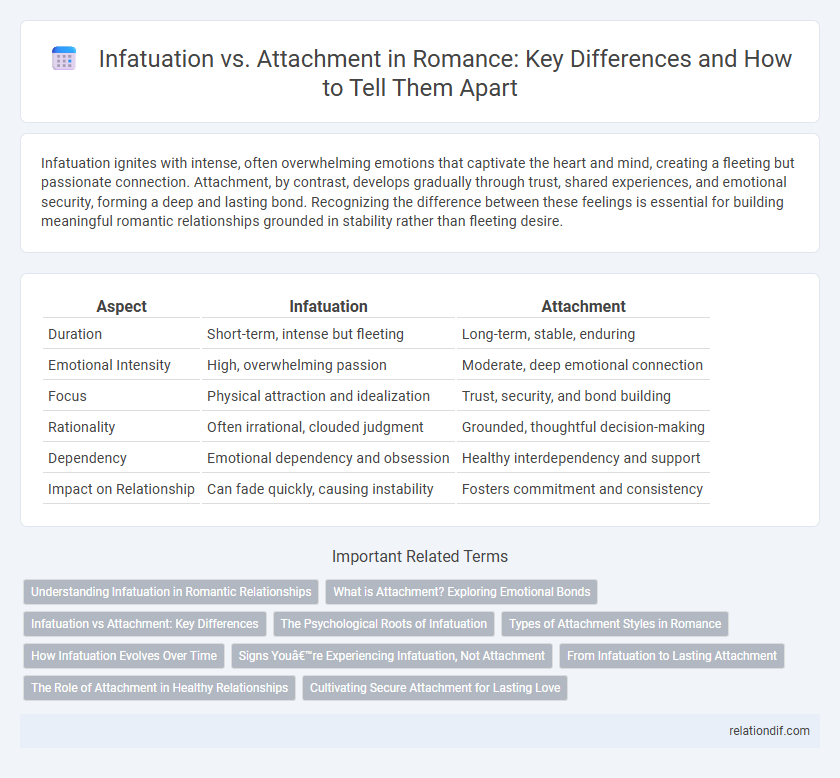Infatuation ignites with intense, often overwhelming emotions that captivate the heart and mind, creating a fleeting but passionate connection. Attachment, by contrast, develops gradually through trust, shared experiences, and emotional security, forming a deep and lasting bond. Recognizing the difference between these feelings is essential for building meaningful romantic relationships grounded in stability rather than fleeting desire.
Table of Comparison
| Aspect | Infatuation | Attachment |
|---|---|---|
| Duration | Short-term, intense but fleeting | Long-term, stable, enduring |
| Emotional Intensity | High, overwhelming passion | Moderate, deep emotional connection |
| Focus | Physical attraction and idealization | Trust, security, and bond building |
| Rationality | Often irrational, clouded judgment | Grounded, thoughtful decision-making |
| Dependency | Emotional dependency and obsession | Healthy interdependency and support |
| Impact on Relationship | Can fade quickly, causing instability | Fosters commitment and consistency |
Understanding Infatuation in Romantic Relationships
Infatuation in romantic relationships is marked by intense, often irrational attraction driven by idealization and emotional highs rather than deep understanding. This phase triggers the brain's reward system, releasing dopamine and creating a temporary sense of euphoria that can overshadow realistic perceptions of the partner. Recognizing infatuation helps distinguish fleeting passion from genuine attachment, which involves trust, emotional intimacy, and long-term commitment.
What is Attachment? Exploring Emotional Bonds
Attachment in romance refers to the deep emotional bond that develops between partners, characterized by feelings of security, trust, and long-term commitment. Unlike infatuation, which is intense but often short-lived passion driven by idealization and physical attraction, attachment fosters stability and emotional intimacy over time. Understanding attachment involves recognizing patterns of care, mutual support, and the desire for closeness that sustain lasting relationships.
Infatuation vs Attachment: Key Differences
Infatuation is characterized by intense, short-lived passion and idealization, often driven by physical attraction and emotional excitement. Attachment develops gradually through trust, shared experiences, and emotional security, leading to a deep, lasting bond. Understanding the shift from infatuation to attachment is crucial for building stable, meaningful romantic relationships.
The Psychological Roots of Infatuation
Infatuation stems from heightened dopamine levels in the brain, triggering intense emotional arousal and idealization of a romantic interest. This psychological state is often linked to novelty and uncertainty, which amplify the excitement and obsessive focus on the partner. In contrast, attachment develops through oxytocin and vasopressin pathways, fostering long-term bonding and emotional security beyond initial attraction.
Types of Attachment Styles in Romance
Romantic relationships often reflect distinct attachment styles: secure, anxious, avoidant, and fearful-avoidant, each influencing how partners connect and respond to intimacy. Infatuation typically arises with an anxious attachment style, marked by intense desire and fear of abandonment, while attachment involves a deeper, secure bond characterized by trust and emotional stability. Recognizing these attachment patterns helps individuals foster healthier, more lasting romantic connections beyond the fleeting nature of infatuation.
How Infatuation Evolves Over Time
Infatuation initially manifests as intense, often overwhelming passion driven by idealization and fantasy, rooted in high dopamine levels affecting emotional responses. Over time, this raw excitement transitions into attachment characterized by oxytocin and vasopressin release, fostering trust, emotional security, and deeper bonding. Understanding this neurochemical shift clarifies why early romantic obsession evolves into stable, long-term love marked by commitment and mutual support.
Signs You’re Experiencing Infatuation, Not Attachment
Rapid emotional highs, obsessive thoughts about the person, and idealizing their qualities are common signs of infatuation, distinguishing it from deeper attachment. Infatuation often involves intense but short-lived passion, lacking the trust and emotional security found in attachment. Recognizing these signs helps differentiate fleeting attraction from meaningful emotional bonds in romantic relationships.
From Infatuation to Lasting Attachment
Infatuation ignites intense passion and idealized perceptions, often clouding realistic judgment in the early stages of romance. Transitioning from infatuation to lasting attachment involves building trust, emotional intimacy, and mutual respect, fostering a deeper, stable bond. Neuroscientific studies reveal that dopamine-driven excitement in infatuation gradually gives way to oxytocin and vasopressin mechanisms that support enduring attachment and commitment.
The Role of Attachment in Healthy Relationships
Attachment serves as the foundation for trust and emotional security in healthy romantic relationships, enabling partners to navigate conflicts with empathy and resilience. Infatuation is characterized by intense but often fleeting emotions driven by idealization, whereas attachment develops through consistent emotional connection and mutual support over time. Secure attachment fosters long-term intimacy and commitment by promoting open communication and a sense of safety between partners.
Cultivating Secure Attachment for Lasting Love
Cultivating secure attachment involves developing trust, open communication, and emotional responsiveness, which are essential for lasting love beyond infatuation. Infatuation often triggers intense but fleeting emotions, while secure attachment fosters deep connection and stability in relationships. Prioritizing mutual understanding and consistency helps transform initial attraction into enduring romantic bonds.
infatuation vs attachment Infographic

 relationdif.com
relationdif.com